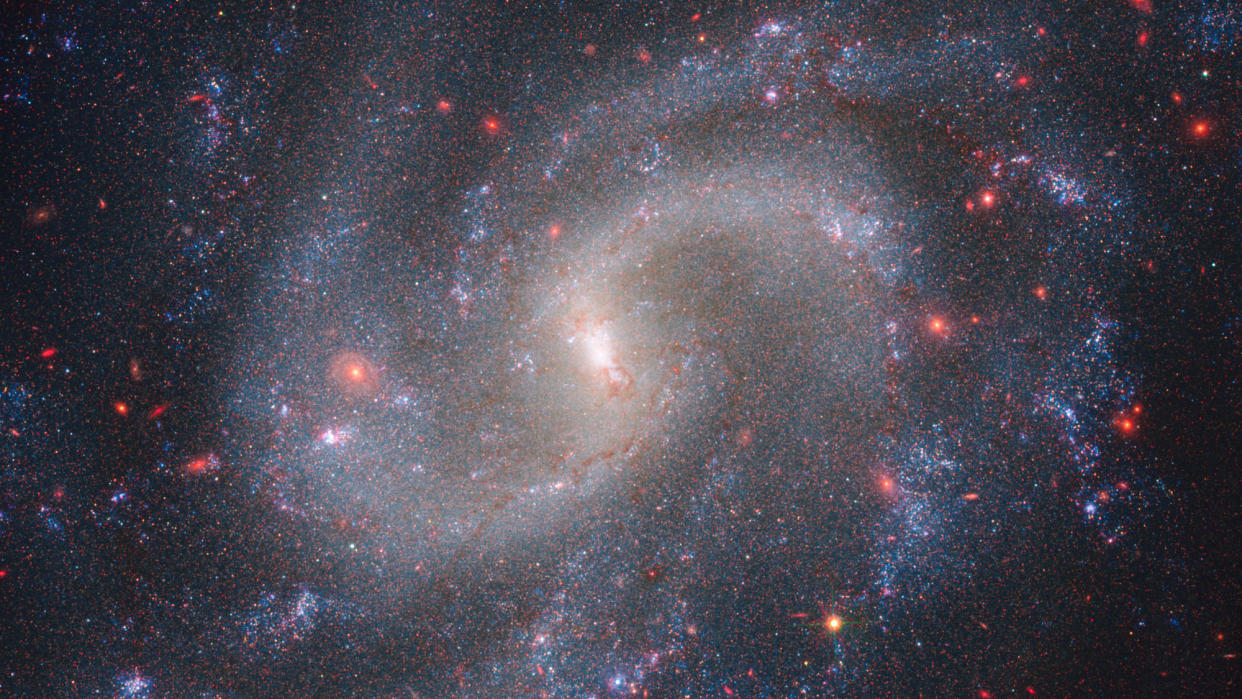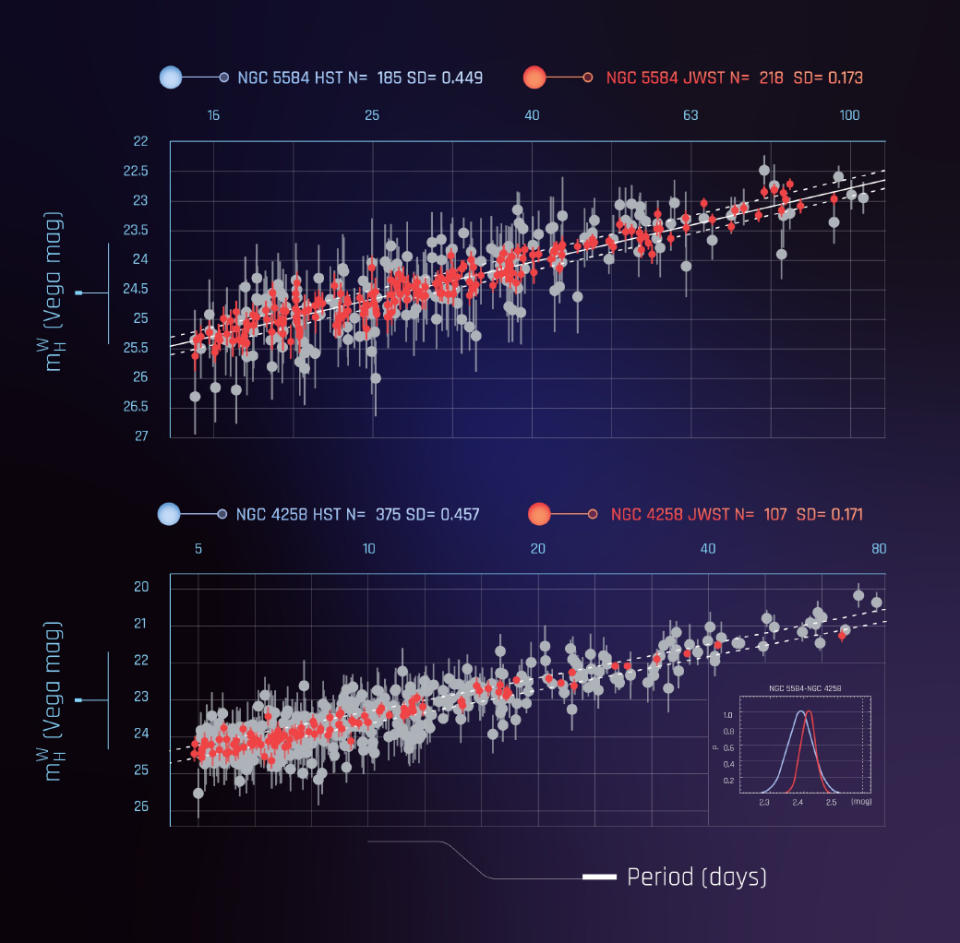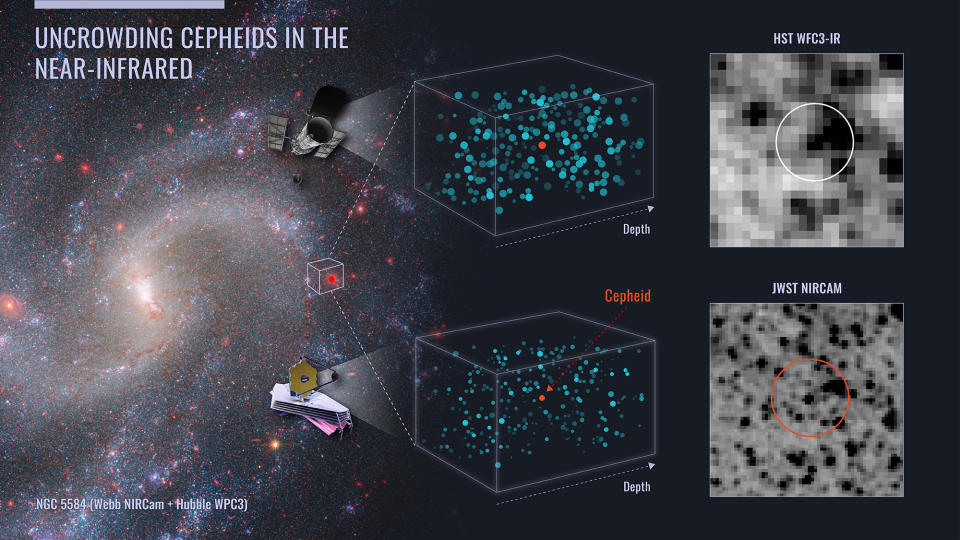James Webb Space Telescope deepens major debate over universe's expansion rate

- Oops!Something went wrong.Please try again later.
One of the biggest and most heated cosmic debates of our time surrounds a peculiar dilemma with a rather snappy name: Hubble tension.
This phrase describes the fact that, even though scientists are aware the cosmos is constantly ballooning outward in every direction — as we can clearly see stars and galaxies drifting farther and farther away from us over time — they can't perfectly pin down the rate at which that ballooning is happening. (And the rate is accelerating, by the way, a startling discovery astronomers made in the late 1990s that could be due in part to the existence of dark energy.)
That leaves us with a pretty major chasm in our understanding of the universe.
In an attempt to get to the bottom of this, on Tuesday (Sept. 12) researchers announced that the James Webb Space Telescope (JWST) has weighed in on the situation for the first time – but it did not solve the mystery. In fact, JWST actually thickened it.
But first, let's talk about how we got here.
Related: Exoplanet's surface may be covered in oceans, James Webb Space Telescope finds
So, what's the problem with calculating the rate?
Basically, settling Hubble tension once and for all is dependent on resolving the true value of the Hubble constant, which is a crucial number in calculating the universe's expansion rate. Yet, for whatever reason, our theoretical predictions of the constant do not appear to match up with reality.
According to most models, the Hubble constant should equal something around 68 kilometers per second per megaparsec (km/s/Mpc). One megaparsec is 1,000 parsecs, or about 3,260 light-years, for context. But after scanning stars and galaxies across our universe, some experts calculate the constant to be 69.8 km/s/Mpc, while others find it to be as high as 74 km/s/Mpc, depending on the method of measurement. Still others have suggested solutions that fall between the two.
Potentially, this discrepancy either suggests our instruments are not intelligent enough — or maybe we're awfully wrong about that theoretical prediction. In other words, perhaps the models that presently thread our understanding of the universe are missing something?
In 2019, a number of high-profile physicists even famously gathered at the Kavli Institute for Theoretical Physics in California to officially try and resolve things. That ended with a headache. As particle physicist David Gross, a former director of the KITP, put it: "We wouldn't call it a tension or a problem but rather a crisis." And ever since, scientists have continued to diligently work out where they might've gone wrong, crossing off possible explanations for Hubble tension on a list you can check out here.
Which brings us to today.
Returning to the JWST's results: The spaceborne observatory crossed one more item off that list. In a nutshell, it showed that the so-called crisis is probably not due to technical issues with measurements made by its telescope sibling that boasts a very relevant name: the Hubble Space Telescope. (Back in the 1920s, the American astronomer Edwin Hubble discovered that the universe is expanding.)
This is a big deal, because Hubble observations are one of the most common features that scientists use to decode the Hubble constant — or more specifically, Hubble observations of Cepheid stars are.
"Webb measurements provide the strongest evidence yet that systematic errors in Hubble’s Cepheid photometry do not play a significant role in the present Hubble tension," Adam Riess, from the Johns Hopkins University and the Space Telescope Science Institute, said in a statement.

'I have your back, Hubble,' said the JWST (probably)
Hubble is a key device used in resolving Hubble tension because it's able to measure stellar brightnesses with incredible precision. That's because it sits above Earth's blurring atmosphere, unlike ground-based observatories hampered by our planet's hazy shield.
Such brightnesses can tell us how far away those stars are and, because we know the immutable speed of light, for how long that light has been traveling to reach us. After some calculations, scientists reason that this kind of information taken from lots (and lots) of stars should help us figure out the Hubble constant.
"Prior to Hubble’s 1990 launch," Riess explained, "the expansion rate of the universe was so uncertain astronomers weren’t sure if the universe has been expanding for 10 billion or 20 billion years."
Furthermore, there is one star in particular that scientists like to focus on with Hubble to tease out the universe's expansion rate: Cepheids. These are supergiant stars with something like 100,000 times the luminosity of our sun.
"They are the gold standard tool for the purpose of measuring the distances of galaxies a hundred million or more light-years away," Riess said, calling such measurements "a crucial step to determine the Hubble constant."
Riess also mentioned that Cepheids pulsate — expand and contract in size — which indicates their relative luminosities. The longer the period, he explained, the intrinsically brighter they are – and this is good because it provides baseline brightnesses and ultimately more accurate measurements.
So, thanks to Hubble's perch above our atmosphere, the telescope can identify individual Cepheids in galaxies more than a hundred million light-years away, thus measuring the time interval over which these galaxies change their brightness.
But Hubble has its limitations.

It's not quite sensitive enough to infrared light wavelengths, which are found beyond the red end of the electromagnetic spectrum and remain invisible to human eyes. "Unfortunately," Riess said, "Hubble’s red-light vision is not as sharp as its blue, so the Cepheid starlight we see there is blended with other stars in its field of view."
Infrared vision is important when peering at faraway objects because, first of all, light coming from distant sources gets stretched out on the way to our vantage point on Earth. Once-tight bluish wavelengths turn into longer, reddish ones. That's actually where the term "redshifted galaxies" comes from, referring to realms falling deeper toward that end of the spectrum from our ground-based perspective.
And second, only infrared light has the ability to pass through dust unscathed, meaning if a Cepheid is stuck behind a shroud of interstellar matter, it'd appear fainter to us. That runs the risk of its light blending in with light from another Cepheid in the vicinity, for instance, or making it seem like a star is farther away than it truly is.
"We can account for the average amount of blending, statistically, the same way a doctor figures out your weight by subtracting the average weight of clothes from the scale reading," Riess said. "But doing so adds noise to the measurements. Some people’s clothes are heavier than others."
Enter the James Webb Space Telescope.
This $10 billion observatory, sitting nearly 1 million miles (1.6 million kilometers) away from Earth, is built to unveil the infrared universe to us.
"In the first year of Webb operations with our General Observers program 1685, we collected observations of Cepheids found by Hubble at two steps along what’s known as the cosmic distance ladder," Riess said.
Related Stories:
— James Webb Space Telescope could determine if nearby exoplanet is habitable
— See Comet Nishimura at its closest point to Earth this week. It won't visit again for 435 years.
— Astronomers may have discovered the closest black holes to Earth
The first step, according to the team, involved observing Cepheids in a galaxy with a known geometric distance for calibration purposes. That galaxy was NGC 4258. The second step was to observe Cepheids in the host galaxies of recent Type Ia supernovas, which are bright star explosions, to basically double check whether Hubble's observations were right. If Hubble was wrong, well, maybe we finally learned why there's a discrepancy.
But Hubble's observations were right.
"JWST, I think, has really kind of put a nail in the coffin of: Was there a problem with Hubble's Cepheid measurements?" Riess said while presenting the research at the JWST's First Year of Science conference on Tuesday.
But notably, the Nobel Laureate researcher does not exactly see this as the crisis it's gradually deemed itself.
"I don't care what the value of the Hubble constant comes out to be," he said during the conference. "I want to understand why our best tools — our gold standard tools — are not agreeing with each other."
A study on these results was posted last month on the pre-print database arXiv. That study has not yet been peer-reviewed.

